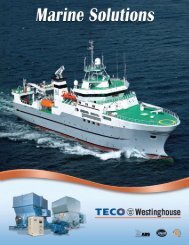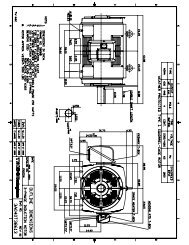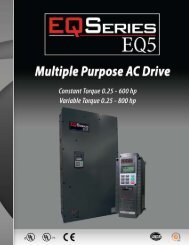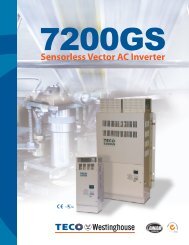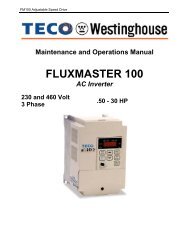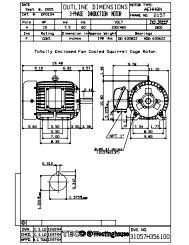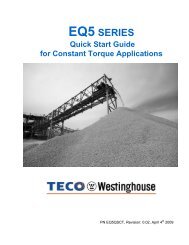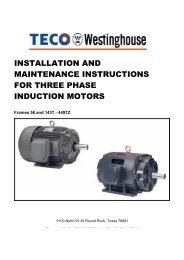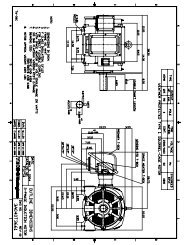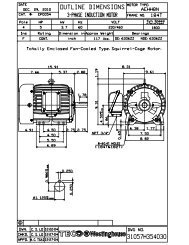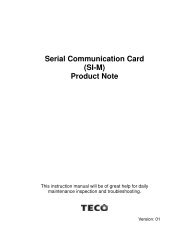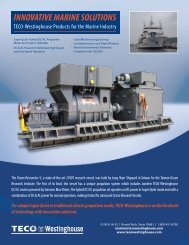EQ7 Series Instruction Manual - TECO-Westinghouse Motor Company
EQ7 Series Instruction Manual - TECO-Westinghouse Motor Company
EQ7 Series Instruction Manual - TECO-Westinghouse Motor Company
Create successful ePaper yourself
Turn your PDF publications into a flip-book with our unique Google optimized e-Paper software.
P05, A19 <strong>Motor</strong> 1 / 2 (Online tuning)<br />
Long run under "Dynamic torque control" or "Slip compensation control" causes motor temperature change,<br />
varying the motor parameters. This changes the motor speed compensation amount, resulting in motor speed<br />
deviation from the initial rotating speed.<br />
Enabling online tuning identifies motor parameters covering the motor temperature change to decrease the motor<br />
speed fluctuation.<br />
To perform online tuning enabled with P05/A19, set P04 (Auto-tuning) to "2."<br />
Note: Online tuning can be performed only when F42 = 1 (Dynamic torque control) or when F42 = 2<br />
(V/f control with slip compensation active) and F37 = 2 or 5 (Auto torque boost).<br />
A46, d04<br />
d12<br />
Speed Control 2, Speed Control 1,<br />
Speed Control (Jogging) (Integral time)<br />
These function codes are used to configure the Automatic Speed Regulator (ASR) by selecting the PI controller or<br />
P controller.<br />
Setting the function code data to "999" selects the P controller.<br />
P06 to P08 <strong>Motor</strong> 1 (No-load current, %R1 and %X)<br />
P06 through P08 specify no-load current, %R1 and %X, respectively. Obtain the appropriate values from the test<br />
report of the motor or by calling the manufacturer of the motor.<br />
Performing auto-tuning automatically sets these parameters.<br />
• No-load current (P06)<br />
Enter the value obtained from the motor manufacturer.<br />
• %R1 (P07)<br />
Enter the value calculated by the following expression.<br />
R1 Cable R1<br />
%R1 <br />
×100 (%)<br />
V / ( 3 × I )<br />
where,<br />
R1: Primary resistance of the motor ()<br />
Cable R1: Resistance of the output cable ()<br />
V: Rated voltage of the motor (V)<br />
I: Rated current of the motor (A)<br />
• %X (P08)<br />
Enter the value calculated by the following expression.<br />
X1 X2 × XM / (X2 XM) Cable X<br />
%X <br />
×100 (%)<br />
V / ( 3 × I )<br />
where,<br />
X1: Primary leakage reactance of the motor ()<br />
X2: Secondary leakage reactance of the motor (converted to primary) ()<br />
XM: Exciting reactance of the motor ()<br />
Cable X: Reactance of the output cable ()<br />
V: Rated voltage of the motor (V)<br />
I: Rated current of the motor (A)<br />
For reactance, use the value at the base frequency (F04).<br />
4-111



